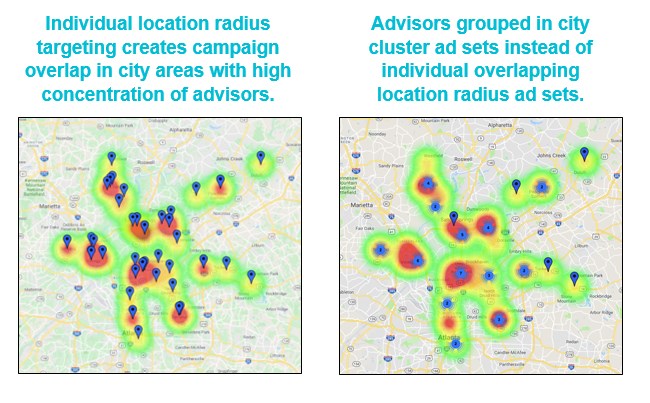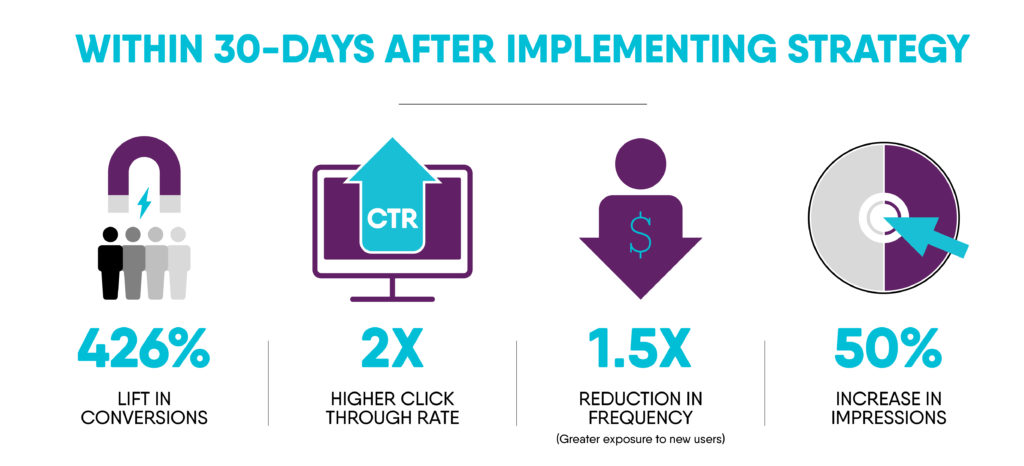[Case Study]: Proactive Campaign Management Prompts Restructure – Results In 426% Lift In Conversions
Mindstream Media Group has successfully supported a long-term Fortune 500 financial services client with digital media solutions including Paid Search, Display and Video. To connect the brand with engaged prospects where they spend most of their time, social media was added to the mix. As the pilot program progressed, campaign tactics were continually tested, and findings were leveraged to curate more efficient strategies.
Overview
The client provides financial services solutions to investors via thousands of financial advisors in offices across regional markets. Paid Social support was first launched through regional Facebook campaigns with ads customized for each participating financial advisor providing personalized exposure and contact information. Since multiple financial advisors service the same zip codes, delivery overlap and saturation within the regional ad accounts developed within three months. Our Paid Media Strategists reviewed the overall landscape including campaign performance metrics to-date and general regional market data to map out a restructure strategy allowing for more optimal delivery.
Re-tooling the campaign to leverage regional clusters enabled us to scale a hyper-local focus according to market size and calculate the most effective way to utilize the budget while reaching the right audiences. Since personalized messaging was maintained with ads specific to each financial advisor, this improvement in efficiency led to a lift in leads at the hyper-local level.
Increased conversions across all markets indicated the restructured cluster campaigns produced a universally positive return across varying DMAs and market types.

Challenge
Individually promote financial advisors participating in the digital program in a manner that enables ad reach and media management at optimal market scale.
Objectives
Strategy for the social media campaign was geared towards boosting new client acquisition by generating qualified leads for individual financial advisors. Presenting potential investors with local financial advisors ready to service their needs also helped to personalize the brand.
Scaling delivery at an efficient cost to provide support for and exposure of individual financial advisors within the potential investor’s local area was critical.
Approach
Mindstream Media Group’s clustering methodology takes city populations within each regional DMA, the number of financial advisors servicing each city and the percent budget allocation that should be assigned accordingly into account. The result groups financial advisors into city cluster ad sets instead of individual overlapping location radius ad sets.
Assigned on a tiered but fluid system, the city cluster budget is directed towards ad sets that show the highest inventory availability during any given hour. This positions each financial advisor ad unit in a competitive manner within the Facebook exchange, allowing for effective coverage of their geographic service area while targeting their ideal audience segments.
Our city cluster solution has resulted in a significant increase in overall conversions (online client lead form submissions). Unique user frequency has also decreased, which enables greater exposure to reach new users across each regional market.

Results
Thirty days after implementing the regional restructured city clusters, conversion volume increased 426 percent, click through rate has doubled from previous monthly averages and frequency has dropped 1.5 times.
The new configuration allows us to spend monthly market budgets in full, enabling us to deliver 50 percent more impressions in respective markets. Although there was a moderate uptick in the CPM rate, the increased inventory cost shows promise of reaching a more qualified audience. Mindstream will continue to build on this success and optimize towards a cost per lead on par with other efficient lower-funnel channels.
Based on this positive trend, these data points will be used to establish preliminary benchmarks to measure the success of future social campaign performance against.

More from Mindstream Media Group

Meet the Mindstreamer – Chandler Swanner
Chandler Swanner’s interest in advertising dates back to her childhood. Her mother (and role model in life) was a Media […]

Third-Party Cookie Phase-Out: What Marketers Need to Know
Cookies are an essential part of internet usage, allowing websites to remember you and provide a more personalized experience. This […]

Meet the Mindstreamer – Kaya Bucarile
She plans and oversees media strategy for agency clients, working closely with project and platform managers to ensure that we […]
